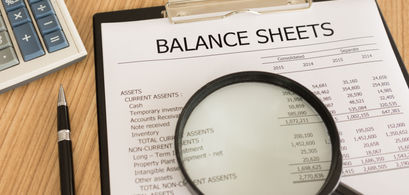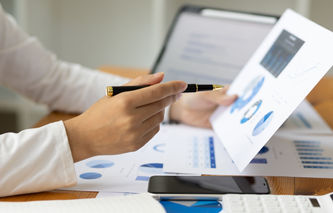While the income statement helps the analyst to understand the profitability of a company, the balance sheet helps them to understand how much a company is worth. The balance sheet does this by reporting how much a company owes (liabilities), how much it owns (assets), and the money held in retained earnings (equity).
In this article, we're going to be providing a better understanding of the balance sheet. We'll do that by first talking about the fundamentals and importance of this accounting report to investors. Next, we'll walk through each segment of this statement, while providing a high-level overview of the typical accounts found in each section. Then we'll finish up by talking about some of the key metrics used by investors to analyze a company's financial health.
The Balance Sheet
Along with the statement of cash flows and income statement, the balance sheet is one of the three most important documents used by investors to understand the financial condition of a company. Structurally, the balance sheet is relatively simple in concept. Every company's balance sheet is comprised of three elements:
Assets: often defined as an economic resource which is owned by the corporation and is expected to provide future benefits to its operation. Accounting rules allow assets to take two forms: Tangible Assets, which have a physical form such as a building or a piece of machinery. Intangible Assets, which usually involve a legal right or claim such as a patent.
Liabilities: these are the debts of a corporation. Nearly all businesses have liabilities; even the most successful and profitable of companies will make purchases on credit. Most companies also find it desirable to borrow money as a means of expanding operations more rapidly. Typical liabilities of the company include long-term debt, notes payable, and accounts payable.
Equity: also referred to as owner's equity and shareholder's equity, these are the resources that have been invested by the owners of the company. Increases in owner's equity comes from two sources: the initial and any additional investments by the owner, as well as earnings resulting from the profitable operation of the company
The relationship of the above three elements in the balance sheet are as follows:
Assets = Liabilities + Owner's Equity
Generally, the importance of the balance sheet stems from its ability to allow investors to analyze the amount of debt a company is carrying relative to the investments it owns and the equity, or worth, of the company.
Assets
The assets appearing on a balance sheet are further subdivided into two broad categories: current assets and non-current assets, which are also referred to as fixed assets. As a reminder, an asset is a resource that has value and is expected to provide a future benefit to the company.
Current Assets
When an asset is expected to be sold or used up in the near term (usually one year or operating cycle), it is categorized as a current asset. This class of assets includes:
Cash and Cash Equivalents: highly-liquid assets that can be readily converted into cash. This includes money market funds, and money held in bank accounts.
Short-term Investments: government bonds and marketable securities that mature in less than one year.
Inventories: goods and materials held in stock by a company that are waiting to be sold.
Accounts Receivable: bills that have been sent to customers for goods and / or services that have been rendered, but not yet paid for by the customer. While receivables have not yet been paid, the company records in this account the value it expects to receive from customers.
Prepaid Expenses: cash that has already been paid to vendors that will eventually turn into an expense in the next 12 months. For example, a one year maintenance agreement on software may have been paid in January, but the benefits of that agreement will be expensed over the next 12 months.
Non-Current or Fixed Assets
This category of assets includes those owned by the company that has not been classified as current assets; this includes:
Plant, Property, and Equipment: these are physical assets and property that is not easily converted into cash. Depreciation represents a decrease in the value of the asset's useful life over time. Plant, property, and equipment (PP&E) is usually recorded on the balance sheet net of depreciation.
Intangible Assets: these are non-physical assets, meaning they cannot be touched or seen and usually cannot be turned into cash. The most common forms of intangible assets include copyrights, patents, trademarks, and goodwill. Most investors are skeptical of the reported value of intangible assets such as goodwill, since this represents the difference between the purchase price of an asset and its fair market value.
Long-Term Investments: bonds with maturities greater than one year as well as the holdings of any stocks of other companies. Long-term investments also include special accounts such as pension funds, sinking funds, and land held for speculative purposes.
Liabilities
A company's liabilities are debt obligations arising from transactions that have occurred in the past. The balance sheet subdivides liabilities into two broad categories: current liabilities and non-current liabilities, also known as long-term liabilities.
Current Liabilities
When a liability is expected to be liquidated in the near term (usually one year or operating cycle), it is categorized as a current liability. This class of liabilities includes:
Accounts Payable: these are bills the company has received for goods or services but has not paid for yet. The cash flow of a company can be improved by taking advantage of payment terms and delaying paying for bills until they are due.
Short Term Debt: this is money the company borrowed for a term of 12 months or less. Short term debt is usually matched against the short term borrowing needs of the company, and is usually in the form of bank loans.
Non-Current or Long-Term Liabilities
As was the case with non-current assets, these liabilities represent the money the company owes creditors with a term greater than 12 months. The most common classes of this liability include:
Notes Payable: also referred to as promissory notes, these are written promises to pay money owed a creditor under terms that include payment due dates as well as the rate of interest charged on the money borrowed.
Long-Term Debt: this is money a company has borrowed, and is typically obtained through the issuing of bonds with a repayment date that is frequently in the distant future. Investors will often evaluate the risk of a company by calculating its interest coverage ratio.
Owner's Equity
Also referred to as shareholder's equity, or simply equity, this is the third major element of the balance sheet. Owner's equity is really just another liability of the company, except in this case the liability resides with the owners of the company. Owner's equity can be further subdivided into two broad categories: Retained Earnings and Treasury Stock.
Retained Earnings
The retained earnings of a company can be thought of as the total profits ever earned, minus all of the money paid to shareholders in the form of dividends. Since the value of retained earnings is cumulative, there can be instances where retained earnings are negative. When that occurs, this account is sometimes renamed as "accumulated deficit" or "retained losses."
Treasury Stock
If stock is issued, then subsequently repurchased by the company, it is held as treasury stock. The repurchase of stock can be an efficient way to increase shareholder value. Companies sometimes repurchase stock when they feel their shares are undervalued by the market. When stock is repurchased and the level of net income is maintained, the earnings per share will increase due to the lower number of shares outstanding.
Balance Sheet Benchmarks
Most financial ratios are derived from two financial statements, the balance sheet and the income statement. When analyzing the balance sheet, keep in mind this report is a snapshot in time. It's also important to understand that one measure doesn't tell the entire story. When analyzing the balance sheet, the best approach involves calculating several ratios and looking for trends in the data.
When calculating financial ratios, the evaluation is usually benchmarked against other companies. The best comparisons include:
Market Averages: these are market-wide averages or financial ratio "rules of thumb" that apply to "generic" companies.
Industry Averages: a better comparison than Market Averages, here the benchmark is against companies in the same or similar industries.
Same Company: finally, ratio analysis can be done using historical, current, as well as forecasts or projections for the same company.
Key Financial Ratios
The following financial ratios are the key metrics that can be calculated using only the balance sheet. This includes the current ratio, quick ratio, and leverage (debt-to-worth).
Current Ratio
Also referred to as the liquidity ratio, the current ratio measures the "solvency" or liquidity of the company. It provides the investor with a measure of the company's ability to pay current liabilities with current assets. The calculation of the measure is:
Current Ratio = Current Assets / Current Liabilities
The higher the current ratio, the greater is the company's ability to pay its short-term obligations using short-term cash. If the current ratio falls below 1.0, the company might find it difficult to repay all its current liabilities.
Quick Ratio
Another measure of liquidity, the quick ratio removes some of the slightly less liquid assets from the current ratio equation. This test of financial strength is slightly more challenging, since it only accounts for a portion of the current assets. The calculation of the quick ratio is:
Quick Ratio = (Cash + Marketable Securities + Accounts Receivable) / Current Liabilities
The higher the quick ratio, the greater is the company's ability to pay its short-term debt obligations using short-term cash. If the quick ratio falls below 1.0, the company might find it difficult to repay all its current liabilities.
Leverage Ratio
Also known as the debt-to-equity ratio and debt-to-worth ratio, the leverage ratio gives the investor a good indication of the company's leverage. For example, if the ratio is high, then assets far exceed stock equity. This indicates the company has a lot of debt relative to equity. The leverage ratio is calculated as:
Leverage Ratio = Total Liabilities / Net Worth (or Total Equity)
While leverage ratios can vary by industry, a rule of thumb when evaluating this measure is the ratio should be no higher than 2:1. This allows for liabilities to be twice the shareholder's equity. When the ratio goes above 2:1, the company may have trouble paying creditors as well as obtaining additional long-term funding.



